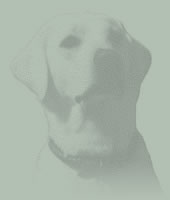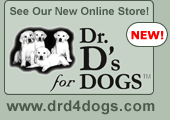 |
Sign Up For Our Newsletter!
 |
||
Feeding Your New PuppySee Also: Feeding
the Adult Labrador | Reproduction | Preventative
Medicine 
Not All Puppy Food Is Created Equal!As we might expect, the young of many species have very particular nutritional requirements. Beginning with the most important first milk they recieve from their mother, called colostrum, through the time they are structurally mature, there is often a fine and delicate balance between normal and abnormal growth and development. Tip the balance to either side of the normal range and a variety of growth related disorders, most frequently affecting the musculo-skeletal system, may become evident. During the mid-late 80's, I had the good fortune to work with veterinarians from the Ohio State University College Of Veterinary Medicine in an extensive project designed to study the relationships between the diet of growing Thoroughbred foals and the rather high incidence of "metabolic bone disease" found on some Central Kentucky horse farms. Various forms of tendon, joint and bone disorders, from mild to severe, were found to be linked to unbalanced diets being fed to these foals. Certainly not all foals were affected as even though the same ration was similarly being fed to all the young horses, there were still many that never manifest any clinical signs of disease. Though you may ask why, the reasons for this are complex and beyond the scope of this discussion. Suffice it to say that, over a period of time, by correcting the rations on many of the farms in the area, the incidence of "metabolic bone disease" in subsequent foal crops was greatly diminished. But back to the dog, and specifically the Labrador Retriever. Unlike the human species, within the canine population there are many different breeds, small to giant in size, each with their own different rates of growth and genetic predispositions. As we approach the year 2000, it is no longer possible to generalize and say that if dog food A is good for raising Schnauzers, then it should also be good for raising Great Danes. The unique nature and tendencies of the various breeds have come under extensive study. One can no longer rely on tradition, "wives tales" or the advertising executives who will gladly "feed you" what they wish in order to sell their products. Unlike some other breeds, the German Shepherd, Golden Retriever, Irish Setter, Labrador Retriever, etc. are very prone to certain "metabolic bone disorders". Conditions such as endostitis, panosteitis, and various cartilaginous problems such as osteochondrosis and others are not uncommon, and can often be traced to nutritional imbalances in the diet of the young, growing puppy. As some may know, I have always made myself available to anyone that has one of our pups should they have any questions whether related to medical topics or simply on general raising and caring for their new pet. Over the years, it seemed I would get more calls regarding intermittent lameness in the adolescent pups than I thought was normal. In nearly all cases, it was found to be what we call endostitis. I can just about diagnose this inflammatory process (which occurs in the long bones) over the telephone by the description of the symptoms given to me by the owners. Although it is a completely reversible condition that will vanish as the bones grow and mature, it unfortunately causes unnecessary expense in having the dog examined and radiographed. Worse yet, the pups usually exerienced periods of mild lameness that require restricted exercise before they returned to normal. Having personally experienced the same problem with my own pups (as I'm sure many breeders have) over the years, I didn't have to go far to know exactly what they were talking about. In the past, we would never recommend any particular ration when sending our pups to their new homes. Mistakenly thinking that puppy food X would probably be just as good as puppy food Z, there is no telling how many different rations were being fed to the dogs went sent out. Our only prerequisite was it be made by a reputable manufacturer and meet the basic nutrient requirements for growing puppies. Several years ago we decided to switch rations. I am very pleased to tell you without hesitation that to this day, we rarely get a phone call regarding that which I discussed above. Having personally witnessed the difference in the pups we've kept and in those we've raised and sent out in the past couple of years, you can understand why I am now very emphatic about what our pups eat and why I specifically express such to the new owners. I am certainly not saying that there is only one way to raise a Labrador Retriever puppy. I'm quite sure there have been many, many Labradors successfully raised on a wide variety of different products. But with the intense competition for the consumer's dollar, we are being bombarded from all sides with this formula, or that formula, designed to make your pet the healthiest and happiest on the block. All rice; no rice; all meat; no meat; all natural; lamb, soy, this, that, and on and on and on. Remember: as is often the case, experience is the best teacher. Feeding Your New Puppy
Following the weaning process, all of our pups are fed on a three times per day schedule and are kept on that format until they leave our home to go to their new families. For the next several weeks, we recommend that you follow a similar pattern until the pup acclimates to his new surroundings and adopts your family's schedule. After a while, you can cut back to feeding twice a day without any problem. This schedule should be followed for a number of months until the growth rate has leveled off, usually around nine to ten months. At that point a once a day feeding schedule is usually sufficient and should be maintained throughout adulthood. As mentioned above, we are very particular about what our pups are eating and we strongly recommend that they are maintained on the same diet as we feed throughout their first year. At that point, you may switch to a different ration so long as the proper nutritional requirements are being met. There are some folks who continue to feed the puppy formula to their young adults and I cannot find any reason to dispute this if the dog is doing well. Some prefer to always have a bowl of dry food available for their pup to eat whenever they desire. While there is technically nothing wrong with doing so, we prefer to feed what the pup should eat and then remove the bowl. This seems to promote better eating habits and ensures that your dog eats when you feed him and not when he wants to. Also, and this is especially important with a young puppy learning the rules of house-training, you are better able to predict bowel movements and prepare accordingly. The young puppy has a very potent gastro-colic reflex. Simply translated, that means that after they eat, you can expect a bowel movement in the not too distant future. By feeding the pup on your schedule and not theirs, you can more readily be prepared to take the pup out following meals, etc. As they grow, this reflex will diminish and will not dictate the dog's bowel movements as it does in the early days. One thing that should always be available to the pup, or any dog for that matter, is a bowl of fresh water. Feeding The Adult LabradorMost adult Labrador Retriever's are hearty eaters and don't have to be coaxed or pleaded with to eat their dinner. Though exceptions do exist to every rule (and we have one of those finicky eaters too), in general, your Labrador will most likely not leave anything in the bowl to be discarded. Some Labs are known to eat their dinner so fast that if you blink your eyes, you might look back to see a pair of pleading eyes wondering where their food has gone. Rest assured it wasn't stolen. This brings up an important point regarding feeding the adult, and although it follows a reference to rapid eating, what I'm about to say is realtive to all Labradors, whether they eat slowly or inhale their food. The condition is called gastric dilatation and torsion and is a very serious and often life threatening situation that can affect not only the Labrador Retriever, but many of the medium to large canine breeds. While it is not our intention to discuss the various medical features of this condition, you should be aware that in many cases it is preventable and that will be the focus of our discussion. As the name implies, gastric dilatation refers to a rapid expansion of the stomach due to gas accumulation and build up. As the stomach swells and pressure increases, the dog experiences a diminshed ability to breath accompanied by a decreased capacity of the heart to pump blood to the vital organs.When a gastric torsion (twisting, as you would twist a balloon) occurs as well as a dilatation, the condition is very critical and surgical intervention is not far away. The condition usually presents with a dog in various degrees of distress characterized by panting, elevated heart rate and a moderate to severely distended abdomen. Immediate veterinary attention is required and any time wasted may compromise the animal's chances for survival. There are several things that you, his master, can do to minimize the risk of this happening to your pet. So as not to give the "do as I say, not as I do" impression, I can tell you that we follow these simple rules rigidly and advise all of the new puppy owners of the benefits. Rather than merely stating my case, a brief exercise will go much further in demonstrating my point. I would like you to stop reading this topic right now (well, after the next sentence or two!) and go to your dog food bag with a regular water glass in your hand. Use a drinking glass that is clear and not colored, for a better picture of what will develop. If you would, fill the glass "half-full" with the dry dog food that you feed. Now fill with water until it reaches the same level as the dog food you just put in the glass. Now set it aside and observe the following: Within seconds, you'll see hundreds of tiny air bubbles being released from the nuggets as they are being displaced by the water. Gradually, the dog food will absorb more and more water and begin to swell, very much like a sponge would do. After five to ten minutes (depending on the density of the nuggets you are feeding) you will see the amount of expansion that the dog food has undergone. What you won't see is the total amount of air (gas) generated in the absorption process. You saw the tiny air bubbles rise through the water. But what you didn't see was how much was given off because it was released into the room. This is nearly the exact sequence of events that occurs when your dog eats plain dry food. Some dogs chew the nuggets more so than others. In any case, realize that after eating, the entire contents of the bowl you just fed is now located in your dog's stomach. And after eating, what does every dog do? They drink water. Of course! And what happens in their stomach? Just remember the glass experiment. The critical difference? You'll remember in the glass example, the air bubbles were released into the atmosphere. In your dog's stomach, the gas has no immediate escape. If you complicate the matter by letting him run around or exercise immediately after eating, you have just initiated a game of russian roulette with your pet's life. So here's how we feed all of our adult dogs. After putting the portions of dry dog food in each dog's bowl, we then add warm water just up to the level of the nuggets. We let it sit for five to ten minutes on the countertop before feeding so that the absorption/expansion process occurs in the bowl, not in their stomach! We allow them to have water after feeding but we do restrict exercise for an hour or so as an added precautionary measure. This process does not seem to affect young puppies, perhaps in part due to the pronounced gastro-colic reflex mechanism that we referred to in the previous section on Feeding Your New Puppy. Thus our discussion is primarily directed at the adult. Following these simple steps can go a long way to protecting your pet from a most devastating disease process. |
||
The Story of Bainbridge | About Us | What Others Are Saying | Memorials | The Home Team | Photography | Your New Puppy | Veterinary Topics | Dr.'s Newsletter | Contact Us | Online Store | Links | Home Page
White Labs by Dr. Joseph Demichael, DVM - The
Labradors of Bainbridge
Ph: (859) 299-6200 | Email: whitelabs@bainbridgelabs.com | Site
Map
© Dr. D’s for Dogs (USA) 2010, Lexington, Kentucky
All worldwide rights reserved. Dr. D’s for Dogs is a trademark
of Dr. J. Demichael, DVM


 When
you first bring your new pup home, there are several things
to keep in mind. The first thing to remember is that he or
she has just left their "family" and are surrounded by new
sights, new smells and a completely new environment. So a
certain time for adjustment is very normal. The duration
of this will vary from pup to pup, and they may experience
periods of loneliness which may mainfest as a lack of normal
appetite. If they don't seem very hungry for the first day
or two, this is usually the reason.
When
you first bring your new pup home, there are several things
to keep in mind. The first thing to remember is that he or
she has just left their "family" and are surrounded by new
sights, new smells and a completely new environment. So a
certain time for adjustment is very normal. The duration
of this will vary from pup to pup, and they may experience
periods of loneliness which may mainfest as a lack of normal
appetite. If they don't seem very hungry for the first day
or two, this is usually the reason.